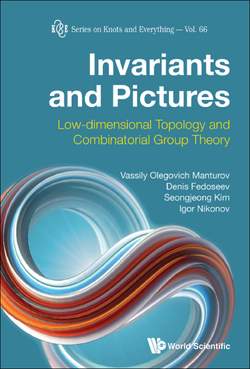Invariants And Pictures: Low-dimensional Topology And Combinatorial Group Theory

Реклама. ООО «ЛитРес», ИНН: 7719571260.
Оглавление
Vassily Olegovich Manturov. Invariants And Pictures: Low-dimensional Topology And Combinatorial Group Theory
Invariants and Pictures
Preface
Acknowledgments
Contents
Chapter 1. Groups. Small Cancellations. Greendlinger Theorem
1.1Group diagrams language
1.1.1Preliminary examples
1.1.2The notion of a diagram of a group
1.1.3The van Kampen lemma
1.1.4Unoriented diagrams
1.2Small cancellation theory. 1.2.1Small cancellation conditions
1.2.2The Greendlinger theorem
1.3Algorithmic problems and the Dehn algorithm
1.4The Diamond lemma
Chapter 2. Braid Theory
2.1Definitions of the braid group
2.2The stable braid group and the pure braid group
2.3The curve algorithm for braids recognition
2.3.1Construction of the invariant
2.3.2Algebraic description of the invariant
2.4Virtual braids. Inclusion of classical braids into virtual braids
2.4.1Definitions of virtual braids
2.4.2Invariants of virtual braids
2.4.2.1A 2n-variable generalisation of the invariant
Chapter 3. Curves on Surfaces. Knots and Virtual Knots. 3.1Basic notions of knot theory
3.2Curve reduction on surfaces
3.2.1The disc flow
3.2.2Minimal curves in an annulus
3.2.3Proof of Theorems 3.3 and 3.4
3.2.4Operations on curves on a surface
3.3Links as braid closures. 3.3.1Classical case
3.3.2Virtual case
3.3.3An analogue of Markov’s theorem in the virtual case
Chapter 4. Two-dimensional Knots and Links
4.12-knots and links
4.2Surface knots
4.3Other types of 2-dimensional knotted surfaces
4.4Smoothing on 2-dimensional knots
4.4.1The notion of smoothing
4.4.2The smoothing process in terms of the framing change
4.4.3Generalised F-lemma
Chapter 5. Parity in Knot Theories. The Parity Bracket
5.1The Gaußian parity and the parity bracket
5.1.1The Gaußian parity
5.1.2Smoothings of knot diagrams
5.1.3The parity bracket invariant
5.1.4The bracket invariant with integer coefficients
5.2The parity axioms
5.3Parity in terms of category theory
5.4The L-invariant
5.5Parities on 2-knots and links
5.5.1The Gaußian parity
5.5.2General parity principle
5.6Parity Projection. Weak Parity. 5.6.1Gaußian parity and parity projection
5.6.2The notion of weak parity
5.6.3Functorial mapping f for Gaußian parity for free, flat and virtual knots
5.6.4The parity hierarchy on virtual knots
Chapter 6. Cobordisms. Applications of Parity Theory to Cobordisms of Knots
6.1Cobordism in knot theories. 6.1.1Basic definitions
6.1.2Cobordism types
6.2Sliceness criteria for certain families of framed graphs
6.2.1Odd framed graphs
6.2.2Iteratively odd framed graphs
6.2.3Multicomponent links
6.2.4Other results on free knot cobordisms
6.3L-invariant as an obstruction to sliceness
Chapter 7. General Theory of Invariants of Dynamical Systems and Groups
7.1Dynamical systems and their properties
7.2Free k-braids
7.3The main theorem
7.4Pictures
Chapter 8. Groups and Their Homomorphisms. Recognition of Free Braids. Explicit Examples
8.1Homomorphism of pure braids into
8.2 Homomorphism of pure braids into
8.3Homomorphism into a free group
8.4Free groups and crossing numbers
8.5Proof of Proposition 8.3
Chapter 9. Generalisations of the Groups. 9.1Indices from and Brunnian braids
9.2Groups with parity and points
9.2.1Connection between and
9.2.2Connection between and
9.3Parity for and invariants of pure braids
9.4Group with imaginary generators. 9.4.1Homomorphisms from classical braids to
9.4.2Homomorphisms from to
9.5-groups for simplicial complexes and the word problem on G2(K)
9.5.1-groups for simplicial complexes
9.5.2The word problem for G2(K)
Chapter 10. Representations of the Groups and Their Connections with Permutahedra. 10.1Faithful representation of Coxeter groups
10.1.1Coxeter group and its linear representation
10.1.2Faithful representation of Coxeter groups
10.2Groups and Coxeter groups C(n, 2)
Chapter 11. Realisation of Spaces with Action. The braid groups for higher-dimensional spaces
11.1Realisation of the groups
11.1.1Preliminary definitions
11.1.2The realisability of
11.1.3Constructing a braid from a word in
11.1.4The group Hk and the algebraic lemma
11.2Realisation of for n ≠ k + 1. Partial flag varieties
11.2.1A simple partial case
11.2.2General construction
11.3The -complex
Chapter 12. Word and Conjugacy Problems in Groups
12.1Conjugacy problem in
12.1.1The existence of the algorithmic solution of the conjugacy problem in the group
12.1.2Algorithm of solving the conjugacy problem in
12.2The word problem for
12.2.1Presentation of the group H4
12.2.2The Howie diagrams
12.2.3The solution to the word ‘problem in H4
Chapter 13. The Groups and Invariants of Manifolds
13.1Projective duality
13.2Embedded hypersurfaces
13.2.1Examples
13.3Immersed hypersurfaces
13.4Circles in 2-manifolds and the group
13.5Immersed curves in M2
13.6A map from knots to 2-knots
Chapter 14. Introduction
14.1The manifold of triangulations
Chapter 15. The Two-dimensional Case
15.1The group definition. A group homomorphism fromPBn
15.1.1Geometric description of the mapping from PBnto
15.1.2Algebraic description of the mapping from PBnto
15.2A group homomorphism from PBn to
15.2.1Geometric description of the mapping from PBnto
15.2.2Algebraic description of the mapping from PBnto
15.3A group homomorphism from PBn to
15.4Braids in3and groups
15.5Lines moving on the plane and the group
15.5.1A map from a group of good moving lines to
15.5.2A map from a group of good moving lines to
15.5.3A map from a group of good moving unit circles to
15.6A representation of braids via triangulations
15.7Decorated triangulations
Chapter 16. The Three-dimensional Case. 16.1The group
16.2The general strategy of defining for arbitrary k
16.3The groups
Chapter 17. Open Problems in the Groups and Theory and Related Fields. 17.1The groups and. 17.1.1Algeb raic ‘problems
17.1.2Topological problems
17.1.3Geometric problems
17.2G-braids
17.3Weavings
17.4Free knot cobordisms. 17.4.1Cobordism genera
17.5Picture calculus. 17.5.1Picture-valued solutions of the Yang–Baxter equations
17.5.2Picture-valued classical knot invariants
17.5.3Categorification of polynomial invariants
17.6Theory of secants
17.7Surface knots
17.7.1Parity for surface knots
17.8Link homotopy. 17.8.1Knots in Sg × S1
17.8.2Links in Sg × S1
17.8.3Degree of knots in Sg × S1
17.8.4Questions
Bibliography
Index
Отрывок из книги
Low-dimensional Topology and Combinatorial Group Theory
Invariants and Pictures
.....
11.Realisation of Spaces with Action
11.1Realisation of the groups .
.....